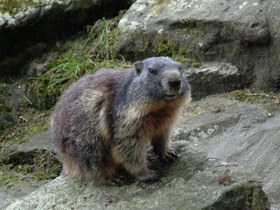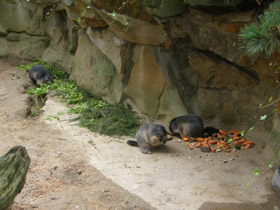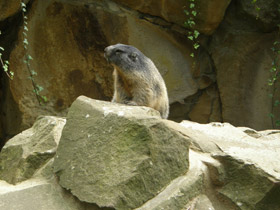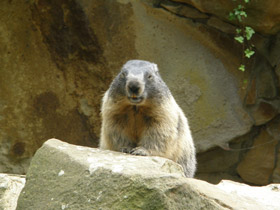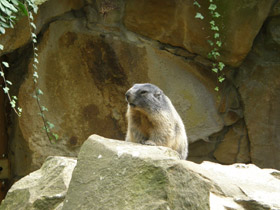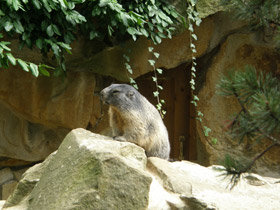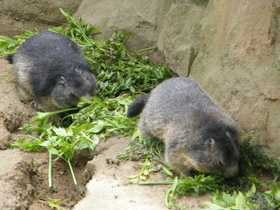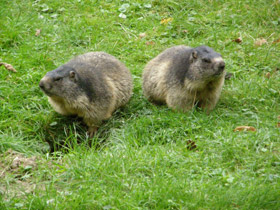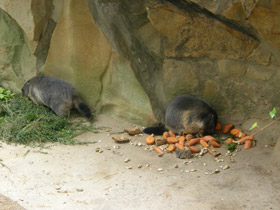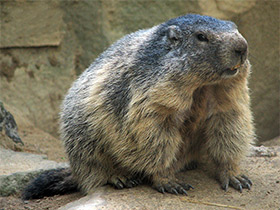The Alpine marmot Marmota marmota
The Alpine marmot is a rodent of the Sciuridae family. It lives on rocky slopes at elevations of 600-3,200 metres above sea level in the Central and Western Alpine mountains of Europe. The Alpine marmot is the third largest rodent in Europe after the beaver and the porcupine; its body length ranges from 40 to 50 cm, with the tail measuring between 10 and 20 cm in length. The body mass of the Alpine marmot changes from season to season but adult males typically weigh at least 3 kg. The fur consists of the dense, strong over hair and shorter, slightly wavy under hair. The ears are small and furred; hind legs have four digits and are a little shorter than the front legs (that have five digits each). Similar to bears, Alpine marmots are plantigrade and have well developed pads on their hairless foot soles.
In early spring, the Alpine marmot diet is based on roots, while at the later stages it also includes leaves and flower heads of various plants. In summer, animals do not face food deficit: they consume just a small proportion of available food and benefit from cattle grazing because it stimulates growth of new fresh plants. Immediately after hibernation period, Alpine marmots eat any available plants but later begin specializing on certain plant species, including Alpine clover, many species of astragalus, and goose-grass. Field studies show that Alpine marmots favour foods rich in polyunsaturated fatty acids because such food components help the animals to increase the energy of their fat reserves stored in adipose tissue for tolerating lower temperatures during hibernation. Alpine marmots are most active in the daytime. These animals usually live in family groups consisting of a pair of adult marmots and their offspring of different ages. The number of animals in family group may reach 20. The Alpine marmot family has a complex social structure and prominent hierarchical interactions, with each member of the pair dominating other marmots of the same sex: dominant male dominates all male offspring and dominant female dominates all female offspring. Similar behaviour is demonstrated towards strangers: intruding adult males are chased away by the dominant male and the same is true for the females. Alpine marmots spend much of the time with members of their family group, grooming each other and playing together.
When alarmed, Alpine marmots stand up on the hind legs and look around; if they notice a predator, they emit a loud whistle that can be heard from a large distance and all the marmots living around immediately escape into their burrows. After some time, they reappear at the entrances of their burrows to check if the predator has gone away. The area of the guarded territory is about 2.5 ha and the dominant pair of marmots marks its boundaries with strongly smelling secretion of buccal glands. Besides, the males regularly patrol the boundaries of their territory, waving their tails and hitting them against the ground. Large burrows that have been built by several generations of marmots usually have widely branched system of chambers and tunnels. Marmots also build summer burrows with nesting chambers located at the depth of up to 1.5 m under ground; these chambers are generally used for the protection from day heat. Short tunnels serve as escape routs if a predator is approaching. Most important component of the labyrinth system is presented by the wintering burrow located at the depth of 7 meters. All burrows have toilet chambers that are used by the animals throughout the year. All members of the family participate in building and cleaning of their burrow. The marmots start building process with excavating soil with their teeth or front legs and then throw the soil out by their hind legs.
The hibernation may last from 6 to 7 months. Hibernation allows the marmots to survive without food through long winter months due to the fat stored in their bodies (during hibernation an individual marmot looses up to one third of its body weight). Shortly before the hibernation period, Alpine marmots collect dry grasses and bring them to the nesting chamber. Hay is used for insulation and as a bedding. The entrance to the burrow is sealed with earth mixed with grass and pebbles and the length of such a barrier may reach seven meters. When finished with their preparation activities, the animals start getting to sleep. Most vulnerable young animals lie in the centre of the nesting chamber and older animals huddle next to them to warm young marmots and each others. During hibernation, the heart rate lowers to five beats per minute, metabolism decreases, and body temperature drops from 370C to 2-30C (which is equal to the ambient temperature in the chamber). The animals wake up every two weeks for about 24 hours. They warm up their bodies to the temperature of 370C, clean themselves and their bedding, and go back to sleep. Interestingly, all marmots wake up at the same time, which helps to minimize the expenditure of valuable energy.
Of all females living in the colony just alpha-female breeds; she mates not only with alpha-male but also with subdominant males (who sire 25% of her offspring). Females do not breed every year; sometimes the interval between two consecutive pregnancies is as long as four years; the frequency of breeding depends on the success of the wintering. After gestation period of five weeks, 2 to 6 hairless, blind, deaf, and toothless pups weighing about 30 grams are born. Their eyes open at the age of 24 days and they are nursed by their mother for six weeks. The pups emerge from the burrow at the age of 40 days; at that time they are able to feed on plants. Alpine marmots do not reach sexual maturity before their second hibernation and start breeding after the third hibernation, living in the family group till the time when they start breeding.

















